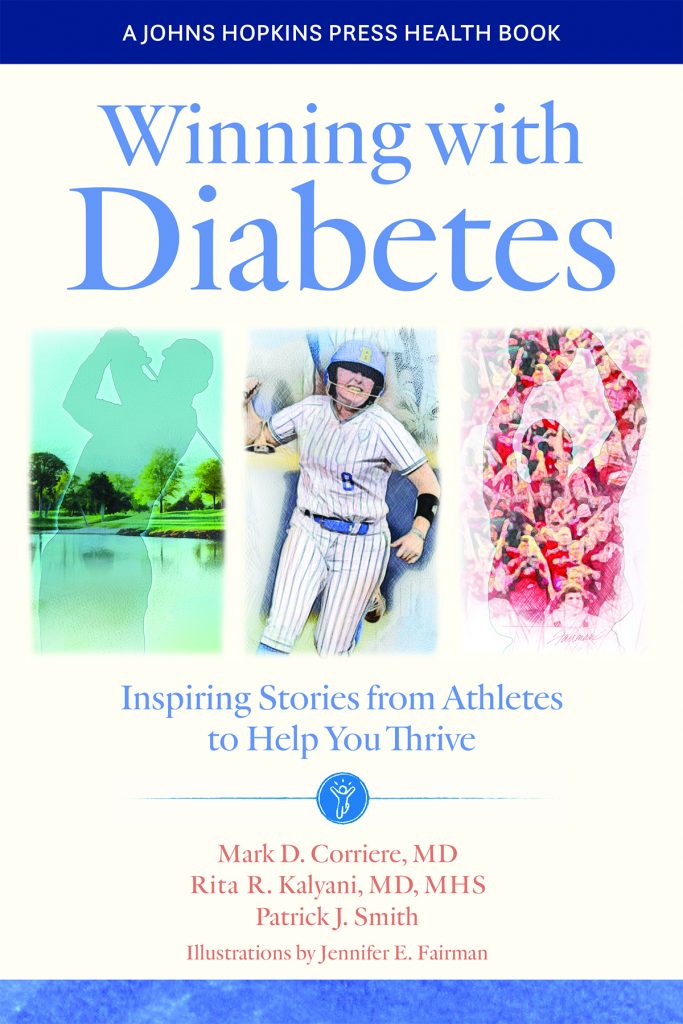
A new book spotlights athletes thriving with diabetes.
In the new book, Winning with Diabetes: Inspiring Stories from Athletes to Help You Thrive, Rita R. Kalyani, MD, MHS; Mark D. Corriere, MD; and Patrick Smith have created an inspirational handbook that clinicians can share with their patients to help them overcome the challenges they may face each day.
Sports can teach us a lot: teamwork, accountability, resiliency. In the preface to the book Winning with Diabetes: Inspiring Stories from Athletes to Help You Thrive published by Johns Hopkins University Press, the authors write that one of the most important lessons from sports is how to bounce back from a tough day. When something isn’t working well, what adjustments can be made for better results? They ask us to imagine a basketball team’s sharpshooter hitting a hot streak, and how the opposing team’s coach would likely call a timeout so the team could regroup and guard the sharpshooter better. “Consider this book a time-out,” the authors write.
“In this book, we approach diabetes using the perspective of the patient experience,” says Rita R. Kalyani, MD, MHS, associate professor of medicine and a diabetes specialist at the Johns Hopkins University School of Medicine in Baltimore, Md. and one of the book’s authors. “We thought that it could be helpful to people with diabetes to hear narratives from a community of people out there who are also struggling with the same challenges, and be inspired by those who have ‘thrived’ with the disease.”
Kalyani and her coauthors – Mark D. Corriere, MD, adjunct assistant professor of medicine at the Johns Hopkins University School of Medicine and clinical endocrinologist at Maryland Endocrine in Columbia, Md, and Patrick Smith, a Baltimore-based journalist and biomedical writer, interviewed 16 elite athletes, from an Olympic gold medalist to a professional mountain climber to a college softball champion, about their challenges with diabetes. Chapters include real-life stories of diagnosis, adapting to new day-to-day routines, finding support, training, competing, and connecting with communities of other people living with diabetes.
The book features advice for facing common fears and challenges, both on and off the playing field, and focuses on firsthand stories from athletes about their experiences living with diabetes, paired with expert commentary from the authors. Chapters also include summaries of key concepts, along with full-page color illustrations and other graphics, all designed to help people with diabetes and the providers caring for them to make the most of their time-out.
Endocrine News sat down with the authors to talk about the inspiration for the book, how these stories can inform optimal clinical care, and how stories like these can help patients with diabetes thrive.
Endocrine News: First off, what was the background of your book, Winning with Diabetes: Inspiring Stories from Athletes to Help You Thrive?
Rita R. Kalyani, MD: Mark and I had previously co-authored a book titled Diabetes Head to Toe: Everything You Need to Know about Diagnosis, Treatment, and Living with Diabetes, along with two other colleagues back in 2018. That book focused more on educational content and summarized, in bite-sized sections, all the different ways that diabetes could affect the body from head to toe. The goal was to educate people with diabetes so they could be aware of the warning signs and symptoms of diabetes-related complications early on and could alert their healthcare provider to seek the appropriate treatment before complications arose.
This book, in some ways, is complementary to the first one. While we highlight important educational concepts in the expert commentary, the focus of the narrative is the athletes’ stories and touches upon what it is like to live day-to-day with diabetes, what are some of the common challenges and successes, and what can anyone who has diabetes learn from those who have been successful in their own professional goals, irrespective of whether they’re an athlete themselves.
We organized the chapters to reflect the life course of a person living with diabetes, from the athletes’ initial diagnosis of diabetes, to learning about diabetes, self-care practices and diabetes, and routine management. One of the key chapters focuses on the athletes’ stories of “winning with diabetes”, or the question of “How can I accomplish my life goals?” These goals don’t have to be athletic pursuits, necessarily. And then the last chapter focuses on building a community, or “How can you give back?” I think we were all impressed by how much these athletes really wanted to give back. Some of them started their own organizations, some of them rode across the country to raise awareness. It was quite remarkable to hear their stories.
Mark D. Corriere, MD: We were looking for a way to highlight people who’ve been successful with diabetes and haven’t let diabetes hold them back in any way. We kicked around a lot of ideas. We talked about telling the stories of politicians, Supreme Court justices, business leaders, actors, all with diabetes. I’ll be honest, I’m a huge sports enthusiast. If I’m not focusing on diabetes or spending time with my family, it’s watching or reading about the Orioles or Notre Dame football. I kept steering these stories back to, “Yeah, you know, that person’s interesting. But did you know this athlete has diabetes?”
The ability to tell these athletes’ stories and show how well they’ve thrived was really something that excited me. We wanted to use the athlete’s success to show you can thrive in any walk of life. Whether it’s heading off to college, starting a new job, or auditioning for a part in a play, diabetes does not need to hold you back.
Patrick Smith: Mark was our sort of bloodhound, so to speak, in reaching out to the athletes. We would just kind of kick around these ideas and go, “Hey, yeah, that person has diabetes.”
And for me, paying attention to things that I didn’t normally pay attention to when I was watching a ball game or listening to something. There’d be a bullet list on the Women’s College World Series, and it would say the second base player or the shortstop has type 1 diabetes. I’d think, “Oh, wow. How about that?” We would make a list and dig down and go find them.
Since the book came out, I’ve seen a good dozen or so other athletes that I thought, “Oh, that would’ve been nice to have that person, him or her, in there too.”
EN: Maybe a sequel.
PS: We’ll see about that.

The way information is communicated makes a huge difference in how it’s received. So many studies that have shown that compassionate communication during interactions between a patient and provider can be nearly as important as taking the medications properly for health outcomes. And I think that effective communication is not only important at diagnosis, it’s also important throughout a lifetime of living with a disease. — Rita Kalyani, MD, MHS, associate professor of medicine, diabetes specialist, Johns Hopkins University
EN: How will these athletes’ personal accounts help readers with diabetes thrive? And can you talk a little about how this sort of camaraderie and community spirit can help patients with diabetes?
RRK: Every individual with diabetes is different. Some people may prefer to be private and manage diabetes on their own; while some might seek the support of others in a more public way. We felt that by sharing the candid stories of individuals who have had challenges but also thrived while living with the disease, that any person living with diabetes and their caregivers could benefit from feeling like they’re a part of that shared community.
The word ‘thrive’ has many definitions, but the one that’s most relevant to the theme of our book is the idea of progressing towards or realizing a goal, either despite or because of circumstances.
In the context of the athletes in this book, we initially sought out to understand how they were so successful professionally despite the fact that they had diabetes. But what we found, instead, is that most of the athletes we interviewed felt that they were successful in part due to the lessons they learned from an early age living with a chronic disease, such as learning self-care practices, healthy eating habits, and the maturity and determination that they needed to self-manage the disease from a young age.
PS: I think about Gary Hall, Jr., the Olympic swimmer, who was at the beginning of the book. He told this incredibly dramatic story where he asked his doctor [after hearing his diagnosis of type 1 diabetes], “What’s this mean? I’m an Olympic swimmer. I’m going to go to Sydney or something. What does it mean?”
“Forget it,” was the answer. The doctor said, “Well, no. You can’t do that competitively. You can swim recreationally, but you can’t be an Olympic swimmer anymore.”
EN: Yeah, the nurse delivering the news to Gary Hall, Jr. that he couldn’t compete with so little compassion struck me. Can you talk about the importance of compassion when delivering news to patients with diabetes?
MDC: It’s never fun news to tell a patient they have a new diagnosis of a chronic disease like diabetes, but just being direct and trying to be as empathetic as you can is the best approach. I emphasize that if we focus on managing your diabetes and make the right changes , this doesn’t have to impact you negatively in your life. It’s important to convey that there’s nothing out there that you can’t really accomplish with diabetes.
My youngest son has a friend he plays sports with that was diagnosed with diabetes at age 8. Understandably, his family was overwhelmed after the diagnosis. I was working on this book project when he was diagnosed and at practices and games would tell his parents about different athletes we had spoken too. They had no idea how many elite athletes have diabetes. I would tell them about the athletes and it was great watching his whole family go, “Wow, all these people have diabetes. They’re so successful. Here’s my 8-year-old-son. As he’s growing, he really can do anything he wants in life. Diabetes doesn’t have to hold him back.”
EN: Right, like IndyCar driver Charlie Kimball’s endocrinologist encouraging him to not give up on his dreams was nice to read. It seems like such a simple and effective way to begin the treatment process: “Don’t let this hold you back.”
RRK: Exactly. The way information is communicated makes a huge difference in how it’s received. So many studies that have shown that compassionate communication during interactions between a patient and provider can be nearly as important as taking the medications properly for health outcomes. And I think that effective communication is not only important at diagnosis, it’s also important throughout a lifetime of living with a disease.
Whether a patient feels like they can openly communicate their experiences with the provider, whether providers effectively communicate important medical information to the patient, and whether there’s trust in the relationship– all these aspects are important.
For parents with young children who have diabetes, these stories can be tremendously encouraging for them as well, to learn of the success stories. That is an audience where we did think that this book could fill a critical need in terms of providing hope and support, especially in those early stages of diabetes diagnosis.
EN: In NFL tight end Mark Andrews’s case, you write that he was able to be an athlete despite his diabetes because he put in the effort to learn about disease and how to take care of himself. Motivation is sometimes a barrier for patients with diabetes. How do you keep your patients motivated?
MDC: I spend a lot of my day talking to patients with diabetes, feeling like I’m a cheerleader. My job is to encourage them and cheer them on and let them know, “Hey, every day’s not going to be perfect, but we’re going to take what we learned today, we’re going to make a change, and tomorrow, we’re going to try and make it better.”
You’re constantly pushing your patients and trying to motivate them and encourage them. Sometimes it works great and sometimes it doesn’t, but you always want to be positive, and you always want to help them move forward and learn from each experience.
Mark Andrews told us story of showing up at college as a wide receiver and they said, “Hey, you’re not going to be a wide receiver. You’re going to be a tight end. Go put on 40 pounds of muscle.” Well, that’s harder to do when you have type 1 diabetes.
So, he had to learn. He worked with the nutritionist there; they tried different things, some worked and some did not. But over time they found something that was successful for him. He could have walked away after the first few weeks and said, “No, I can’t gain weight, sorry,” and he wouldn’t be an all-pro in the NFL. He kept persisting and didn’t allow his diabetes to be an impediment.

RRK: That was a common thread, the lifelong learning. And while things change as circumstances change, I think that was one thing that was true of all the athletes we talked to, which is how trial and error was important. I think that approach to chronic disease, that you will have to learn new things along the way, was very important to their success.
You asked about how we can keep patients motivated. To further add to what Mark talked about, celebrating small successes is important. I think that often, especially in clinical practice, we’re focused on having patients achieve their metabolic goals, for instance, an A1C less than 7%. But if an individual starts from an A1C of 10% and you see them in clinic a few months later and their A1C is 8.5%, that is something to celebrate and to use as a basis for encouragement to continue working towards their goals.
As endocrinologists, we work as part of a comprehensive care team. The diabetes educators are also incredibly important in facilitating that motivation and providing patient education, and truly being partners in this process of helping people with diabetes attain their individualized metabolic targets. So, it’s not a solo endeavor.
PS: [Professional basketball player] Lauren Cox was a really interesting case too, because she was really candid about getting discouraged. Some of the people we interviewed, they were all candid, but maybe they didn’t get discouraged. But anyway, she did and said some days, it’s just really hard and you just kind of break down.
EN: My next question was about Lauren Cox. How important is it for patients to hold their heads up the best they can?
RRK: I’ll draw upon a direct quote from Lauren Cox to highlight a common challenge that people with diabetes can face. She told us, “I did everything right. It was just one of those days.”
I think that’s a sentiment that many people with diabetes can relate to. We know there’s going to be unpredictable situations that lead to swings in blood glucose. Sometimes, these glucose fluctuations could be related to stress, an infection, insulin pump malfunction, or sometimes you just don’t know.
And I think that’s the frustrating part, when you just don’t know the reason for the unpredictability. But it underscores the importance of having a supportive network and being educated on how to handle and approach those unpredictable situations.
MDC: There’s a part of the book where we talk about how you can do things the same way, eat the same foods, exercise in the same way, take your medicines in the same manner, and get completely different outcomes from one day to the next. It can be incredibly frustrating.
Lauren Cox told us a story like this from her freshman season on the Baylor basketball team. We heard similar stories from other athletes who shared, “Sometimes it just wasn’t my day. I did everything the way I normally do it, and it just didn’t work out the way we wanted it to that day.”

You’re constantly pushing your patients and trying to motivate them and encourage them. Sometimes it works great and sometimes it doesn’t, but you always want to be positive, and you always want to help them move forward and learn from each experience. — Mark Corriere, MD, adjunct assistant professor of medicine, Johns Hopkins University; clinical endocrinologist, Maryland Endocrine
EN: Discrimination still happens to patients with diabetes, as you write in the case of professional mountain climber Will Cross and former Major League Baseball pitcher Jason Johnson. What more can be done to break down stigmas and barriers?
RRK: In general, the Americans with Disabilities Acts does require all employers to support the needs of people with diabetes in the workplace. But we know that’s unfortunately not always true, especially in some professions that still require waivers or exemptions such as the military, law enforcement, or aviation.
Ensuring that supervisors are educated on the needs of the employee with diabetes is the first step. Technology has greatly facilitated diabetes management in the workplace. For instance, individuals with diabetes do not necessarily have to go to a private area to prick their finger as they may have had to do in the past, and instead can see their glucose numbers in real-time on a smartphone. But there are many dietary modifications that might still be needed throughout the workday. People might need to snack in between meals, or take insulin injections multiple times a day if they’re not on an insulin pump, and educating colleagues is ongoing process. But hopefully, with more information, employers are better equipped to respond and meet the needs of an individual with diabetes.
EN: What is main thing you would like endocrinologists treating diabetes and people living with diabetes to gain from reading this book?
MDC: For me, it’s exactly that diabetes doesn’t have to hold you back from anything you want to achieve in life. If you have a goal in life, set your goal, then try to achieve it. Incorporate diabetes as part of your plan.
A common theme emerged from many of the athletes we spoke to. They felt they were successful not in spite of their diabetes but because of it. Having diabetes meant they needed to pay more attention to their training, nutrition, recovery and every aspect of their sport. Many felt this was actually an advantage to them. This doesn’t have to just be athletics. The same principles apply to business, in law, in politics, in school, in whatever you want do in life. So, don’t let diabetes hold you back in any way, shape, or form.
RRK: I think from the perspective of the endocrinologist, acknowledging the experiences of a person living with diabetes and what it’s like day-to-day to live with a chronic disease is imperative to delivering patient-centered care. That’s perhaps one of the most important things we want endocrinologists to take away from the book. We also hope endocrinologists can use insights from the athletes’ stories to guide how they interact with their own patients who have diabetes, in order to help them achieve the best health outcomes they can.
We want to emphasize that these stories were intended to be broadly relatable for people with diabetes, not just those who are engaged in serious athletic pursuits or even amateur athletic pursuits. We use the athletes’ stories as a lens through which to highlight the common challenges and successes that an individual with diabetes can encounter during their lifetime, while at the same time recognizing that each individual’s experiences living with diabetes will be distinct.
I think this last quote from Sebastien Sasseville, a Canadian mountain climber and distance runner who summited Mount Everest and ran across Canada, summarizes the takeaway message nicely. He said, “I’ve used diabetes as a purpose, a reason to do these difficult things. I have a disease that forces me to live a healthy life. I want to figure out my full potential and see what I can do.” And, as endocrinologists, it is our job to facilitate that success for our patients with diabetes no matter what they pursue. It’s not always easy but it is definitely possible.

